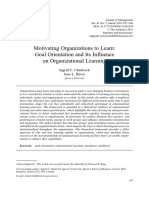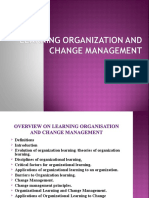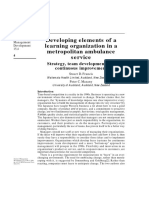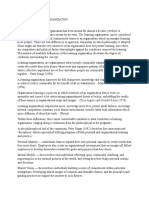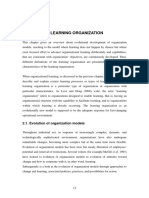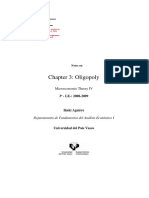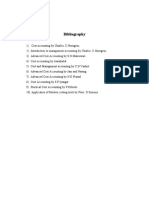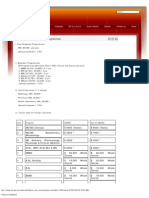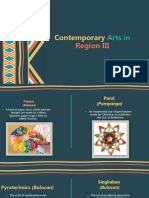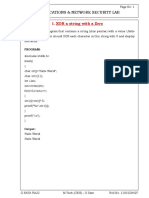Benchmarking The: Learning Capability of Organizations
Benchmarking The: Learning Capability of Organizations
Uploaded by
ዝምታ ተሻለCopyright:
Available Formats
Benchmarking The: Learning Capability of Organizations
Benchmarking The: Learning Capability of Organizations
Uploaded by
ዝምታ ተሻለOriginal Title
Copyright
Available Formats
Share this document
Did you find this document useful?
Is this content inappropriate?
Copyright:
Available Formats
Benchmarking The: Learning Capability of Organizations
Benchmarking The: Learning Capability of Organizations
Uploaded by
ዝምታ ተሻለCopyright:
Available Formats
EuropeanManagementJournalVo[. 15, No. 5, pp.
575-583, I997
© 1997 Elsevier Science Ltd
~ Pergamon All rights reserved. Printed in Great Britain
PII: S0263-23 73(9 7)00036-4 0263-2373/97$17.00+ 0.00
Benchmarking the
Learning Capability of
Organizations
SWEE GOH, University of Ottawa
GREGORY RICHARDS, Consulting and Audit Canada, Ottawa
Implementation of organizational learning is com- (1993), 'most discussions of organizational learning do
plicated by the lack of a systematic approach that not get to the heart of how to make it happen in
includes the measurement of learning capability. We organizations. Their focus is on high philosophy and
propose that by identifying and measuring the grand schemes, sweeping metaphors rather than the
essential organizational characteristics and manage- gritty details of practice' (p. 79). A similar view is held
ment practices that promote organizational learning, by Ulrich, Jick and Von Glinow (1993), who comment
one could develop a benchmark of learning capa- that 'to date there have been far more thought papers on
bility that would enable managers to design inter- why learning matters than empirical research on how
ventions to overcome specific barriers in building a managers can build learning capability' (p. 59). The
learning organization. Based upon a review of the purpose of this paper is to discuss some of the gritty
literature, we developed an Organizational Learning details of practice in building learning organizations.
Survey (OLS) to measure learning capability. Our
research with five different organizations indicates
that the OLS does discriminate between organiza- Building Learning Organizations: A
tions on those characteristics important to learning. Managerial Perspective
We also discuss the implications of using such an
approach for intervention and change in building
One of the main problems with the implementation of
more effective learning organizations. The paper
organizational learning is that no methodology for
also discusses other perspectives of organizational
measuring organizational learning capability exists. This
learning, some of the limitations of the OLS
paper reviews the current literature from a managerial
measurement scale and future research directions.
perspective and then discusses the results of an empirical
© 1997 Elsevier Science Ltd
study designed to develop such a methodology,
The rapidly changing business environment of the 1990s Some researchers in this field take a conceptual approach
has caused managers and researchers alike to search for describing why learning is important for organizations
new ways to develop organizations capable of and outlining the process of organizational learning. ::::::: ::: :
continuous adaptation and, more importantly, capable Others take an applied approach; they seek to elucidate
of anticipating the need for change. Organizational what managers should do to build a learning
learning, a concept which promotes continuous organization. The following discussion provides an
adaptation and improvement, has therefore captured overview of 'applied' papers that propose action plans
the imagination of managers seeking to survive the and managerial practices designed to promote
current turbulent operating environment. organizational learning.
However, implementing organizational learning is not an Two of the most widely quoted papers on managerial
easy task. Although the literature on this topic has application of organizational learning are DeGeus's
grown rapidly over the past few years, there is still no (1988), on the role of planning in Shell, and Stata's
systematic, measurable approach available for practical (1989) paper on his experiences at Analog Devices.
application of this concept in organizations (Garvin, DeGeus's approach at Shell included the use of scenarios
1993; Ulrich, Jick and Von Glinow, 1993; Calvert, in the strategic planning process that encouraged
Mobley and Marshall, 1994). According to Garvin managers to review and challenge commonly accepted
European ManagementJournal Vo115 No 5 October 1997 ,575
BENCHMARKING THE LEARNING CAPABILITYOF ORGANIZATIONS
assumptions. The rationale was that learning will not experimentation, and an ability to learn from past
happen until managers expose hidden assumptions and success and failures. The authors suggest that these
experiment with new scenarios. Stata's experience at practices will enable organizational renewal and develop
Analog Devices, a large technical manufacturing firm, new sources of competitive advantage.
showed that learning can be accelerated through
activities such as minimizing the response time to Nevis, DiBella and Gould (I995) suggest that the
external changes, using planning and quality leaming process includes three basic stages: knowledge
improvement as learning tools. acquisition, knowledge sharing and knowledge
utilization. Based upon these three principles, the authors
Shaw and Perkins (1991) describe a set of key factors have developed a comprehensive model of
derived from their work with a number of organizations organizational learning that includes seven 'learning
that should be implemented to build a learning orientations' and ten 'facilitating factors'. Learning
organization. These include, bringing in external people orientations focus on issues such as sources of
to challenge the assumptions of employees, create knowledge; the facilitating factors focus on practices in
special funds and allow time for employees to the organizations such as openness and continuous
experiment and to create, extract and disseminate experimentation. The authors conclude that
learning. organizations can acquire, share, and utilize knowledge
in different ways depending upon how the orientation
Leonard-Barton (1992), in a study on Chaparral Steel (a and facilitating factors are coordinated. Most
large US steel producer), documents a program that importantly, they suggest that before introducing
features an emphasis on problem solving, constant interventions to improve leaming, an organization
integration of knowledge, continual innovation and should assess its current practices and capabilities with
experimentation, and integration of extemal information respect to leaming.
into day-to-day activities. Chaparral Steel's management
system features a culture of egalitarianism backed up by Pedler, Boydell and Burgoyne (1989), in a study of a
a reward system that encourages the kind of behaviours number of companies on the learning company as
desired. competitive advantage, list a set of conditions describing
a learning company. Some of these conditions include:
Dixon (1993) proposes that learning can occur at the
individual, team and systemic levels in an organization. o;, individuals, groups and departments exchanging and
The three areas are interrelated and specific sharing information on expectations and feedback
organizational systems can be developed to promote on satisfactions to assist learning
learning at all levels. The author suggests that to o~o information systems that enable members to
encourage learning, an organization should generate a question current operating assumptions and seek
holistic view of the organization, acquire and interpret information for individual and collective learning
information from the environment, provide only o;- culture and management style within the
minimum specifications for jobs, facilitate alliances with organization encourage experimentation, leaming
other organizations and implement systems that retain and development from success and failures
knowledge. The author provides examples of companies
who have implemented some of these processes and The themes and conditions they identified as part of
concludes that not all will work in any one situation; their study is consistent with the other studies reviewed
each organization needs to experiment with different here.
methods for improving learning.
These papers together provide a compelling list of
McGill and Slocum (1993), in a discussion of the need to specific suggestions for developing learning
'unlearn' old methods before learning new ones, suggest organizations, and more importantly, give examples of
that openness to different experiences, a willingness to successful applications. It is obvious that many
acknowledge failures and to learn from them, and an similarities exist among the various sets of
orientation to continuous experimentation are important recommendations. But with such a wide variety of
behaviours that promote organizational learning. From different interventions to choose from, the problem of
an organizational design perspective, structures that are where to start becomes problematic. One would have to
flexible and permeable, information systems that provide ask if the recommendations in the various papers were
timely information and a reward system that recognizes not specific to a particular organization with a particular
creativity and experimentation are required if culture in a particular industry. If so, managers seeking to
organizations are to learn effectively. implement these studies as guidelines would have to
ensure that there is some degree of concordance
Slocum, McGill and Lei (1994), after reviewing a number between their organizations and those featured in the
of strategic approaches to managing adaptation and various studies, and then select intervention strategies
learning such as SWOT analysis and the Boston accordingly.
Consulting Group's product portfolio, suggest that the
new learning strategy for organizations must include a Most of the research also suggests that the organizations
strategic intent to learn, a commitment to continuous in question were facing a specific problem; learning
5 76 EuropeanManagementJournalVol 15 No 5 October 1997
BENCHMARKING THE LEARNING CAPABILITYOF ORGANIZATIONS
became a one-time solution. Will these practices work definition, Garvin argues that for this to apply to any
when the organization is not faced with a problem/Does organization requires that the organization actively
success build complacency as suggested by authors such manage the leaming process to ensure that it occurs
as Levitt and March (1988) and Hedberg (1981)? How by design rather than by chance. Distinctive policies and
do we create organizations that continue to learn in the managerial practices are responsible for success and they
absence of a crisis? Indeed, one would assume that a form the building blocks of learning organizations.
learning organization, by virtue of its ability to
anticipate and adapt to change, would rarely have to The objective of this research is to measure the
deal with crisis situations. managerial practices that facilitate organizational
learning or the conditions and enablers that can help
an organization to become a leaming organization. It can
Organizational Learning Capability be argued that measurement of learning per se is
probably not possible nor useful as organizational
To answer some of these questions, we conducted a learning occurs in different ways and forms as
research project to develop a measurement tool for organizations continually have to learn how to survive
assessing the learning capability of an organization. The and adapt to changing conditions (Prahalad and Hamel,
rationale was that organizational learning is really the 1990). Obviously some succeed and others do not.
product of individual and group learning applied to the
accomplishment of the organization's vision and In order to remain competitive and survive, the
performance goals and that certain management challenge is not only to help organizations learn or
practices and intemal conditions can either help or increase their knowledge base but to help them to learn
hinder this process (Duncan and Weiss, 1979; Hall and more effectively. Therefore, our assumption is that
Fukami, 1979; Senge, 1990; Garvin, 1993; Mills and organization learning does happen, but that conditions
Friesen, 1992). Thus, if we can identify and assess the and managerial practices are needed and that the
impact of a set of internal organizational conditions and organization should be appropriately structured and
management practices that lead to leaming, we could managed for effective learning to occur.
assess an organization's learning capability. This
information could then help managers focus on specific In essence our research objective is to measure the
interventions required to improve leaming. capability of the organization to add to their knowledge
base in an effective manner and then to utilize it to
The literature on organizational leaming has developed modify its behaviour over time. We are not proposing
different orientations in how learning can be built. In that this model captures all the conditions and
discussing this issue, DiBella (1995) has identified what managerial practices that are enablers to the learning
he calls the normative perspective of a learning capability of an organization nor does it measure any
organization. This perspective best describes the outcome variables such as performance.
orientation of our research and this paper, that is,
learning is a collective activity that takes place under
certain conditions or circumstances. Therefore, Characteristics of a Learning
organizations need to create the necessary conditions Organization: A Normative Approach
to foster and allow learning to take place.
By analyzing the commonalties among the various ,::~:::,::~::::::::::~:::~::::~:~:~
Developing a learning organization is not random
recommendations found in our earlier literature review, iii:i:i:i:i:!:i:i:?i~i:i:i:i:i:i:i~
chance but a deliberate intervention by leaders to
we identified five major underlying organization
establish the necessary internal conditions for the
characteristics and management practices that are key
organization to operate in a learning mode. The implicit
conditions essential for learning to take place in an
assumption is that there is an organizational archetype :::::::::::+:::::::+:::/::: ::
organization. These five prescriptive organizational
which defines a successful learning organization which in
learning dimensions are mentioned by more than one
turn influences the performance, long-term effectiveness
writer. They are as follows.
and survival of the organization.
This normative perspective moves us away from the
quandary of the definitions and descriptive literature and 1. Clarity of Purpose and Mission
confusion about the learning organization. However, as a The organization as a whole, and each unit within it,
working definition from this normative perspective, we needs to have a clearly articulated purpose. Employees
adopt the definition by Garvin (1993): need to understand this purpose and how the work they
do contributes to attainment of the mission of the
A learning organization is an organization skilled at creating, organization. In addition, the organization needs to
acquiring and transferring knowledge and at modifying its promote employee commitment to these goals. Senge
behaviour to reflect new knowledge (p. 80). (1990, 1992) and others have stated that 'building a
shared vision' especially of a future desired state creates
In a brief review of some organizations that may fit this tension that leads to learning. Employees understand the
European ManagementJournalVo115 No 5 October 1997 ,577
BENCHMARKING THE LEARNING CAPABILITYOF ORGANIZATIONS
gap between the vision and the current state and can 4. Transfer of Knowledge
better strive to overcome that gap (Mohrman and
Mohrman Jr., 1995). Communication needs to be clear, fast and focused.
Information should cross functional and sub-unit
boundaries within the organization. The type of
information acquired and distributed should relate to
2. Leadership Commitment and organizational problems and opportunities. This is again
Empowerment mentioned by the majority of writers, especially the
ability of the organization to transfer knowledge across
Leaders need to be committed to the accomplishment of departmental boundaries and to transfer knowledge from
organizational goals and to the goal of learning. the external environment, e.g. from suppliers, customers
Moreover, leaders need to create a climate of and even from benchmarking of competitors (Garvin,
egalitarianism and trust where people are approachable 1993; Shaw and Perkins,1991 and Pedler, Boydell and
and failures are a part of the learning process. Burgoyne, 1989).
Specifically, leaders need to help identify performance
gaps and then help set goals that encourage the search
for knowledge to narrow and solve these performance 5. Teamwork and Group Problem Solving
gaps.
In today's complex world, individuals need to help each
other accomplish organizational objectives. Structures
Leadership is mentioned by virtually all writers as an and systems in the organization need to encourage
important element in fostering a learning climate teamwork and group problem-solving by employees and
through their behaviours, such as seeking feedback, reduce the dependency on upper management. Teams
being open to criticisms, admitting mistakes and need to also have the ability to work cross-functionally.
empowering their employees to make decisions and By working in teams, knowledge can be shared among
take some risks (Garvin, 1993; Slocum, McGill and Lei, organizational members and there is also a better
1994). understanding of other individuals, their needs and
how they work in different parts of the organization,
encouraging knowledge transfer as well (Senge, 1990,
3. Experimentation and Rewards 1992; Garvin, 1993). Figure 1 summarizes the five
characteristics discussed.
Problems faced by the organization present
opportunities for experimentation. The organization's These five underlying organizational characteristics or
structure and systems need to support this practice. management practices are by no means exhaustive.
Budgeting systems, for example, can be designed to However, based on our literature review, we argue that
challenge the need for doing things because 'we have they capture a set of consistent organization conditions
always done them', and compensation systems can be and management practices that are important for
designed to reward innovation and risk-taking. This is building learning organizations (Garvin, 1993).
by far the most consistent managerial practice that is
observed in learning organizations. The freedom to
experiment with new work methods and innovative The Organizational Learning Survey
processes are encouraged and supported (Senge, 1990;
Garvin, 1993, Pedler, Boydell and Burgoyne, 1989: To review, our rationale is that organizational learning is
Slocum, McGill and Lei, 1994). dependent upon individual and group learning, and that
(1) Clarity of mission and vision
The degree to which employees have a clear vision/mission of the organization and understand how they can
contribute to its success and achievement.
(2) Leadership
The role of leaders in the organization with respect to helping employees learn and elicit behaviors that are
consistent with an experimenting and changing culture.
(3) Experimentation
The degree of freedom employees enjoy in the pursuit of new ways of getting the job done and freedom to take
risks.
(4) Transfer of knowledge
The systems that enable employees to learn from others, from past failures and from other organizations.
(5) Teamwork and group problem-solving
The degree of teamwork possible in the organization to solve problems and generate new and innovative ideas.
Figure 1 Characteristics of a Learning Organization
5 78 European ManagementJournal Vo115 No 5 October 1997
BENCHMARKING THE LEARNING CAPABILITYOF ORGANIZATIONS
this learning gets transferred into organizational learning for about four years.
when a certain set of organizational characteristics and Organization 3 (ORG3) is a large (approximately
management practices are present as discussed above. 2000 employees) private sector telecommunications
We therefore sought to develop a survey tool that can firm within a semi-regulated environment.
assess whether these characteristics or conditions exist in Organization 4 (ORG4) is a small (approximately
organizations. 200 employees) private sector high technology
communications firm with an emphasis on research
and development.
Research Methodology
Questionnaires were distributed to staff at all levels in
the organizations. A total of 632 responses were
Scale Development and Reliability received in total.
After developing a 55-item questionnaire that captured
all of the elements found in the literature grouped into
the five dimensions discussed earlier (clarity of mission Expected Findings
and purpose, leadership commitment, experimentation
and rewards, transfer of knowledge, teamwork and group We predicted that, if the OLS could truly discriminate
problem solving), we refined the questions through a among the organizations in terms of their ability to
series of focus groups. Next, 100 employees from two learn, ORG1 would be lowest on the scale due to the
different organizations were asked to fill in the restrictive nature of the federal govemment environment
questionnaire. Factor analysis was then used to identify with respect to clarity of purpose, experimentation,
a reduced set of questions that was statistically consistent leadership and transfer of knowledge. ORG2 would be
with a single factor. This factor with the reduced 21 items slightly higher that ORG1 in that SOA status provides a
explained 46.7 per cent of the total variance. We retained bit more freedom in these areas. ORG3 and ORG4, as
these 21 questions which captured all five dimensions knowledge-intensive private sector companies were
described earlier. The survey items are provided in the expected to score highest on the scale. But since
Appendix to this paper. This final 21-item questionnaire ORG3 was recently formed through a series of mergers,
was then distributed to employees in five different it was still undergoing some of the pains common to
organizations. The current reliability of this 21-item scale merged organizations. It also operates in a semi-
is 0.90, (Cronbach's alpha). Questionnaire items are regulated environment, so we expected it to score lower
shown in the Appendix at the end of this paper. than ORG4 but higher than both public sector
organizations.We expected ORG4 which is, and still is
considered to be a high performing high-tech firm, to
As part of the reliability testing, we also examined the
score best overall.
stability of the scale with a sample of subjects over time
The test-retest was carried out with a group of graduate
business students (n = 25), who filled the OLS and then
completed it again about 10 weeks later. The test-retest Results
correlation between time 1 and time 2 for the same
sample was r = 0.77, p < 0.01. The Organizational Leaming Survey (OLS) features 21
questions separated into five sub-scales: clarity of
purpose, leadership, experimentation and rewards,
Research Sample transfer of knowledge, and teamwork. The highest i:iiiiiiiii!iiiii:i!!:iii ¸¸:::
:iiiiiiiiiiiiiiii:!i7
possible score is 7, the lowest is 1. Average overall
We then tested this scale with a number of different scores for each organization are depicted in Figure 2.
organizations. Organizations were selected that we Actual results are in the direction of expected results
thought would represent a continuum of learning discussed earlier. ,:.:::.,:.:.:::.:.:.:::.:::.:+:.:
capability. All five were in knowledge intensive fields ~:::x:.::::::::::::::::.:::::::::::
:::i;::'::::i:ix::::::iii?:::ill
such as training or telecommunications. The As expected, ORG4 scored highest overall. This could
organizations have asked not to be identified, but a be explained by a number of factors: it is relatively small,
brief description of each follows: is in a competitive knowledge intensive field, and its
main tasks are research-oriented. Therefore, employees
Organization 1 (ORG1) is part of a public sector need enough freedom to pursue innovative product
federal government department. Its 300 employees development and the organization must be designed
are mostly scientists who work in a laboratory around this basic premise. Its small size reduces the need
environment. for too much formalization or bureaucracy, and the fact
Organization 2 (ORG2) is a public sector federal that it is in a competitive market means that to survive, it
government agency of approximately 550 has to continually learn from its environment. Finally, as
employees. It is called a Special Operating Agency a research organization one assumes that it has learned
(SOA), which means that it needs to operate on a how to manage information and knowledge effectively.
cost-recovery basis, and has received a little freedom
from the rules that govern the rest of the More detailed scores of each dimension of the OLS for
government bureaucracy. ORG2 had been an SOA each of the organizations are shown in Figure 3. It can be
EuropeanManagementJournalVol 15 No 5 October 1997 5 79
BENCHMARKING THE LEARNING CAPABILITY OF ORGANIZATIONS
OLS Scores
7
5 4.6
3.8 4.02
4 3.51
0
ORG 1 ORG 2 ORG 3 ORG 4
(n=190) (n=155) (n=134) (n=153)
Figure g Organizational Learning Survey: Overall OLS Scores
OLS Scores
OLS Dimensions:
mMission
mLeadership
mExperiment
BKnow.Trans.
r-]Teamwork
2
0
ORG 1 ORG 2 ORG 3 ORG 4
(n=190) (n=155) (n=134) (n=153)
Figure 3 Average Scores on Specific OLS Dimensions
seen that as we move from public sector to private sector satisfaction, where we expected a positive correlation
organizations, the scores tend to improve mirroring the with the OLS scale. That is, organizations that score high
overall OLS score results shown in Figure 2. on the learning organization capability scale would also
score high on overall job satisfaction. This was
As part of the survey we also included two other scales confirmed for the overall sample with a significant and
to assess some preliminary evidence of convergent and positive correlation between the OLS and job
discriminant validity of the scale. The first was job satisfaction, r = 0.64 (p < 0.001), n = 429. The scale
580 EuropeanManagementJournalVo115No 5 October1997
BENCHMARKING THE LEARNING CAPABILITYOF ORGANIZATIONS
has 10 items, and the reliability was 0.86 Cronbach's can be further broken down into specific
alpha. team results.
Step 4: Team meetings revolve around small focus
The second scale was the degree of formalization in the groups. Purpose is to work through the data
organization. We expected that the correlation would be and to create an acceptance of responsibility for
negative between the OLS and formalization, as highly the data and to problem solve. That is, to
formalized organizations would constrain some of the understand cause--effect relationships of the
characteristics of a learning organization that we data and to make plans for constructive
identified, for example, the existence of rules and changes.
regulations. The results also confirmed this with a Step 5: Researcher was involved in meetings and served
significant negative correlation between the OLS and as a resource person.
formalization, r = -0.23 (p < 0.001), n = 429. The Step 6: Plans to re-measure the organization about 6-
scale has 7 items and the reliability was 0.72 Cronbach's 12 months later and to compare where
alpha. improvements have been made.
Step 7: Re-evaluate action plans and implementation
The results show some preliminary evidence of the process. Establish new targets, goals and
validity of the scale in measuring organizational learning improvement process in each area.
capability. Although we did not measure performance in Step 8: Continue improvement process.
our sample of four organizations, ORG4 with the
highest score, is considered as one of the most profitable This systematic process for building a learning
high-technology firms with the largest market share of organization uses a reliable instrument that allows for
the product they sell. concrete feedback to allow teams in the organization to
problem-solve and develop plans for improving specific
organizational characteristics and management practices
Implications for Building Learning to facilitate a learning environment. It also helps
Organizations members to focus on areas where improvement is
needed and to develop consensus on what to do.
Based on these preliminary results, the OLS shows
promise as the basis of a systematic approach for In many cases, improvement through implementation of
measuring the learning capability of organizations. these organizational characteristics and management
Results of this survey can be used to benchmark an practices can lead to a complete restructuring and the
organization against others and to provide more development of a new culture in the organization. This
concrete feedback for managers to identify strengths process of change can by itself be an organizational
and weaknesses with respect to organizational learning learning activity (Mohrrnan and Mohrman, Jr., 1995).
capability.
The OLS also allows for a more specific focus by Conclusions
managers as to what needs to be improved and
changed. Data from the survey can help to unfreeze an The concept of organizational learning is of vital
organization by providing an impetus for leaming in importance to both private and public organizations.
addition to its use as an intervention tool for building a Organizational life currently features shorter product
more effective learning organization. This approach is cycles, global competition, increased workplace III!II::IIIIIII%IIILI
consistent with the survey feedback comprehensive diversity, and the constant need to 'do more with less'.
organizational development intervention that has been In such an environment, faster learners will have a
shown to be a highly effective change technique distinct advantage: they will find ways to improve work
(French and Bell, 1995). An approach we have used processes and will find breakthroughs in product and
with one of the organizations in our sample is as service development before their slower learning
follows: competitors. But, if managers are to improve the ability
of organizations to learn, they should approach it
Step 1: Discussion with senior managers on the systematically by focusing on specific interventions
learning organization and the focus of the designed for this purpose.
OLS. Planning as to the steps in the
intervention process. Using the OLS as a measurement tool, a systematic
Step 2: Data using the OLS is collected from all approach would see managers measuring the current
members of the organizational unit. Target is capability of the organization to leam, providing specific
to obtain at least an 85 to 90 per cent response interventions in high impact areas, then reassessing
rate to increase acceptance of data as being learning capability at regular intervals. Each of the
valid. dimensions on the scale could lead to a variety of
Step 3: Data is fed back to senior executive team different interventions. These would be selected bearing
with comparative benchmark data. This flows in mind the strategic intent of the organization,
down to the next level. Data at this point leadership style of managers, size of the organization
European Management Journal Vol 15 No 5 October 1997 5 81.
BENCHMARKING THE LEARNING CAPABILITY OF ORGANIZATIONS
and the tasks performed, and the readiness of employees The OLS is only a partial tool to help managers and
for change. organizations in a more structured way to build a
learning organization environment. Information derived
We are cognizant that there are criticisms of this from this should be used and interpreted with some
normative approach and there are other perspectives that caution as they are aggregate self-report measures from
are just as legitimate in examining and understanding organizational members. However, with a high response
organizational learning. For example others argue that rate, it can be used as an effective survey feedback,
we should not take a completely prescriptive approach organizational development change intervention tool in
but to view organizational learning as a neutral construct conjunction with other change levers, such as rewards
(Argyris and Schon, 1996); or that there is no one best and training, to build a competitive learning
way for being a learning organization (DiBella, 1995). organization.
This other perspective assumes that all organizations (Note: The organizational leaming survey instrument is
learn over time and as they solve problems and create available from the authors)
new cultures they create core competencies which
represent collective learning and a knowledge base in
the organization (Prahalad and Hamel, 1990). They Appendix
argue for a descriptive analysis and identifying the
'mechanisms whereby learning is taking place' (DiBella, T e x t of I t e m s in t h e O r g a n i z a t i o n a l L e a r n i n g
I995). By determining the dominant leaming styles,
S u r v e y Scale
managers can then better understand how learning is
presently occurring in their organizations. Clarity of Purpose and Mission
1. There is widespread support and acceptance of the
However, there is no specific methodology for organization's mission statement.
measuring these learning behaviours or styles. In the 2. I do not understand how the mission of the organization is
end they suggest that interventions such as organization to be achieved (r).
development can be used to propel organizations to 3. The organization's mission statement identifies values to
which all employees must conform.
their next stage of development in an orderly,
4. We have opportunities for self assessment with respect to
constructive progression (DiBella, 1995). In essence the goal attainment.
end result is still an intervention strategy to facilitate
organizational competencies in learning abilities.
Leadership Commitment and Empowerment
5. Senior managers in this organization resist change and are
We argue that a normative approach with a specific afraid of new ideas (r).
measurement tool would be more effective as an 6. Seniormanagers and employees in this organization share a
intervention process. As Garvin (1993) has said, common vision of what our work should accomplish.
'managers have long known that if you can't measure 7. Managersin this organization can accept criticism without
it, you can't manage it' (p. 89). The data from a survey becoming overly defensive.
such as the OLS can help members of an organization 8. Managersin this organization often provide useful feedback
focus on a better understanding of transfer of that helps to identify potential problems and opportunities.
knowledge, teamwork or experimentation from both a 9. Managers in this organization frequently involve
employees in important decisions.
cognitive and eventually a behavioural sense. This
measure also allows for linking these activities to
performance improvement, which needs to be Experimentation
established in further research. 10. I can often bring new ideas into the organization.
I1. From my experience, people who are new in this
organization are encouraged to question the way things
Although the OLS did discriminate between the are done.
organizations in this study which lends credence to its 12. Managersin this organization encourage team members to
validity and its use as a possible benchmarking tool for experiment in order to improve work processes.
the development of learning organizations, additional 13. Innovative ideas that work are often rewarded by
research is needed. Further research studies should focus management.
on assessing the knowledge base developed by an I4. In my experience, new ideas from emloyees are not treated
orgapization, identifying how this knowledge is utilized seriously by management (r).
to improve organizational effectiveness and
performance. This may involve a longitudinal study Transfer of Knowledge
with pre-test and post-test measure with the OLS and 15. I often have an opportunity to talk to other staff about
also documenting any interventions made and relevant succesfu]programs or work activities in order to understand
why they succeed.
performance measures. Other research questions need to
16. Failures are seldom constructively discussed in our
be answered as well, for example, what kinds of organization (r).
interventions work best in what organizations, how 17. New work processes that may be useful to the organization
does the personality of leaders impact learning, and how as a whole are usually shared with all employees.
can employee training programs contribute to 18. We have a system that allows us to learn successful
organizational learning. practices from other organizations.
582, EuropeanManagementJournalVol 15 No 5 October 1997
BENCHMARKING THE LEARNING CAPABILITY OF ORGANIZATIONS
Teamwork and Group-Problem Solving Nystrom and W.H. Starbuck (eds.), Handbook of
I9. Current organizational practice encourages employees to Organizational Design, OxFord Press, New York.
solve problems together before discussing them with a Leonard-Barton, D. (1992) The factory as learning laboratory.
manager. Sloan Management Review, Fall, pp. 23-38.
20. We cannot usually form informal groups to solve Levitt B. and March J.G. (1988) Organizational learning. Annual
organizational problems (r).
Review of Sociology, 14, pp..319--410.
McGill, M. and Slocum, J.W., Jr. (1993) Unlearning the
21. Most problem solving groups in this organization feature organization. Organizational Dynamics, Autumn, pp. 67-79.
employees from a variety of functional areas. Mills, D.Q. and Friesen, B. (1992) The learning organization.
European Management Journal, vol. 10, no. 2, pp. 146-156.
References Mohrman, S.A. and Mohrman Jr., A.M. (1995) Organizational
change and learning. In Galbraith, J.R., Lawler, Ed, E. (III)
Argyris, C. and Schon, D. (1996) Organizational Learning Ih and associates. Organizingfor the Future: The New Logic for
Theory, Method and Practice, Addison-Wesley Publishing Managing Complex Organizations.Jossey Bass, San Francisco.
Company. Nevis, E.G., DiBella, A.J. and Gould, J.M. (1995) Understanding
Calvert, G., Mobley, S. and Marshall, L. (1994) Grasping the organizations as leaming systems. Sloan Management
[earning organization. Trainingand Development, voL 48, no. Review, Winter, pp. 73-85.
O, June, pp. 39-43. Pedler, M., Boydell, T. and Burgoyne, J. (1989) Towards the
DeGeus, A.P. (1988) Planning as learning. Harvard Business learning company. Management Education and Development,
Review, March-April, pp. 70-74. vol. 20, part 1, pp. 1-8.
DiBella, A. (1995) Developing learning organizations: A Matter Prahalad, C. and Hamel, G. (1990) The core competencies of the
of Perspective. Academy of Management Proceedings, pp. corporation. Harvard BusinessReview, May-June, pp. 79-91.
287-290. Senge, P. (1990) Building leaming organizations. Sloan
Dixon, N. (1993) Report to the Conference Board of Canada on Management Review, Fall, pp. 7-23.
Organizational Learning. Senge, P. (1992) The Fifth Discipline. Doubleday, New York.
Duncan, R. and Weiss, A. (1979) Organizational learning: Shaw, R.B. and Perkins, D.N.T. (1991) Teaching organizations to
implications for organization design. Research in Organiza- leam. Organizational Developmental Journal, vol. 9, no. 4,
tional Behaviour, vol. 1, pp. 75-123. Winter, pp. 1-12.
French, W.L. and Bell, C.H. (1995) Organization Development: Slocum, J.W., McGill, M. and Lei, D.T. (1994) The new learning
Behavioral Science Interventions for Organization Improvement, strategy: anytime, anything, anywhere. Organizational
5th ed., Prentice-Hall Inc. Dynamics, Autumn, pp. 33-47.
Garvin, D. (1993) Building a learning organization. Harvard Stata, R. (I989) Organizational leaming - - the key to
Business Review, July-August, pp. 78--91. management innovation. Sloan Management Review, Spring,
Hall, D.T. and Fukami, C. V. (1979) Organizational design and pp 63-73.
adult learning. In Research in Organizational Behaviour. Ulrich, D., Jick, T. and Von Glinow, M. (1993) High impact
B.Staw (ed.), JAI Press Inc., pp. 125-107. learning: building and diffusing learning capability.
Hedberg, B. (1981) How organizations learn and unlearn. In P.C. Organizational Dynamics, Autumn, pp. 52-60.
SWEE G O H , University of GREGORY RICHARDS,
Ottawa, Faculty of University of Ottawa.
Administration, P.O. Box Faculty of Administration,
450, Stn. A, Ottawa, P.O. Box 450, Stn. A,
Ontario K I N 61'45, Canada. Ottawa, Ontario K I N 6N5,
Canada.
Swee Goh is Associate
Professor of Organizational Gregory Richards is a Senior
Behaviour and Human Consultant at Consulting
Resource Management at the and Audit Canada, and
University of Ottawa. His teaches organizational
areas of current research behaviour at the University
include the measurement and implementation of of Ottawa. His research and consulting interest are in
organizational learning in public and private sector the areas of developing learning organizations in the
organizations and the management of large-scale public and not-for-profit sectors.
organizational transformations.
European ManagementJournal Vol 15 No 5 October 1997 ,58 3
You might also like
- Learning in Action: A Guide to Putting the Learning Organization to WorkFrom EverandLearning in Action: A Guide to Putting the Learning Organization to Work3/5 (1)
- The Science of Training and Development in Organizations: What Matters in PracticeNo ratings yetThe Science of Training and Development in Organizations: What Matters in Practice28 pages
- Quality of Scientific Studies: (CITATION Sha20 /L 1033) (CITATION Sha20 /L 1033)No ratings yetQuality of Scientific Studies: (CITATION Sha20 /L 1033) (CITATION Sha20 /L 1033)6 pages
- Promoting Intra-Firm Transfer of Knowledge Through Competition and SharingNo ratings yetPromoting Intra-Firm Transfer of Knowledge Through Competition and Sharing18 pages
- Developing A Learning Organization A Case StudyNo ratings yetDeveloping A Learning Organization A Case Study25 pages
- Learning Capability and Business Perform PDFNo ratings yetLearning Capability and Business Perform PDF20 pages
- Assignment: Summarize Article " By: Swee C.Goh: Toward A Learning Organization: The Strategic Building Blocks"No ratings yetAssignment: Summarize Article " By: Swee C.Goh: Toward A Learning Organization: The Strategic Building Blocks"10 pages
- Organizational Learning. Proposal of An Integrative Scale and Research Instrument (Begoña, 2013)No ratings yetOrganizational Learning. Proposal of An Integrative Scale and Research Instrument (Begoña, 2013)6 pages
- A Study of The Impact of Organizational Learning On Information System EffectivenessNo ratings yetA Study of The Impact of Organizational Learning On Information System Effectiveness32 pages
- Learning Organization and Change ManagementNo ratings yetLearning Organization and Change Management20 pages
- Linking Training Programs To Employee Performance: A Theoretical ReviewNo ratings yetLinking Training Programs To Employee Performance: A Theoretical Review6 pages
- Dynamic Organizational Learning: A Conceptual Framework: Kris M.Y. Law and Angappa GunasekaranNo ratings yetDynamic Organizational Learning: A Conceptual Framework: Kris M.Y. Law and Angappa Gunasekaran7 pages
- Learning Journal Week 3 Unit 3 Bus 1101 Principles of Business ManagementNo ratings yetLearning Journal Week 3 Unit 3 Bus 1101 Principles of Business Management4 pages
- Organisational Learning and Six Sigma Deployment Readiness EvaluationNo ratings yetOrganisational Learning and Six Sigma Deployment Readiness Evaluation19 pages
- A_framework_for_the_facilitation_of_accelerated_leNo ratings yetA_framework_for_the_facilitation_of_accelerated_le11 pages
- Organizational Learning Capacity and Organizational Effectiveness: The Moderating Role of Absorptive Capacity - Christian Sunday ChukwuekezieNo ratings yetOrganizational Learning Capacity and Organizational Effectiveness: The Moderating Role of Absorptive Capacity - Christian Sunday Chukwuekezie6 pages
- Keywords-Transformational Leadership Human Resource Management PracticesNo ratings yetKeywords-Transformational Leadership Human Resource Management Practices31 pages
- Fostering A Learning Organization: "If It Isn't Broken, Don't Fix It"No ratings yetFostering A Learning Organization: "If It Isn't Broken, Don't Fix It"4 pages
- Developing Elements of A Learning Organization in A Metropolitan Ambluance ServiceNo ratings yetDeveloping Elements of A Learning Organization in A Metropolitan Ambluance Service16 pages
- Learning Organization and Organizational Commitment in SchoolsNo ratings yetLearning Organization and Organizational Commitment in Schools8 pages
- The Impact of Organizational Learning On Work PerformanceNo ratings yetThe Impact of Organizational Learning On Work Performance6 pages
- A Formal Model For The Fifth Discipline Part II - Detailed VersionNo ratings yetA Formal Model For The Fifth Discipline Part II - Detailed Version98 pages
- Topic:: "Impact of Training & Development On Employee Performance in Textile Industry"No ratings yetTopic:: "Impact of Training & Development On Employee Performance in Textile Industry"3 pages
- Integrating Leadership Development and Succession Planning Best PracticesNo ratings yetIntegrating Leadership Development and Succession Planning Best Practices25 pages
- 20140926090933bill Buckler Learning Process ModelNo ratings yet20140926090933bill Buckler Learning Process Model11 pages
- Learning Orientation, Firm Innovation Capability, and Firm Performance100% (1)Learning Orientation, Firm Innovation Capability, and Firm Performance10 pages
- The Science of Training and Development PDFNo ratings yetThe Science of Training and Development PDF28 pages
- Leading Organizational Learning Reflections On Theory and Research0% (1)Leading Organizational Learning Reflections On Theory and Research3 pages
- The View Through A Different Lens: Investigating Organizational Learning at The Group Level of Analysis100% (1)The View Through A Different Lens: Investigating Organizational Learning at The Group Level of Analysis20 pages
- The Application of Motivation Theory in Manufacturing CompanyNo ratings yetThe Application of Motivation Theory in Manufacturing Company6 pages
- A Learning Organization Perspective On Knowledge-Sharing Behavior and Firm InnovationNo ratings yetA Learning Organization Perspective On Knowledge-Sharing Behavior and Firm Innovation11 pages
- Environment, Management Attitude, and Organizational Learning in AlliancesNo ratings yetEnvironment, Management Attitude, and Organizational Learning in Alliances11 pages
- Team Learning in Projects: Theory and PracticeFrom EverandTeam Learning in Projects: Theory and PracticeNo ratings yet
- Authorized Branch Establishment With GradeNo ratings yetAuthorized Branch Establishment With Grade3 pages
- Letters of Credit - In-Depth Understanding: Master Class (25 Year)No ratings yetLetters of Credit - In-Depth Understanding: Master Class (25 Year)1 page
- Chapter 3: Oligopoly: Microeconomic Theory IVNo ratings yetChapter 3: Oligopoly: Microeconomic Theory IV38 pages
- Commercial Bank of Ethiopia Talent Acquisition and Management Candidates of Management TraineeNo ratings yetCommercial Bank of Ethiopia Talent Acquisition and Management Candidates of Management Trainee2 pages
- Atm Manual: Commercial Bank of Ethiopia E-Payment Technical TeamNo ratings yetAtm Manual: Commercial Bank of Ethiopia E-Payment Technical Team7 pages
- Unit 9: Joint Products, Cost Allocation and by Products ContentNo ratings yetUnit 9: Joint Products, Cost Allocation and by Products Content20 pages
- Worksheet For Cost and Management Accounting I (Acct 211)No ratings yetWorksheet For Cost and Management Accounting I (Acct 211)9 pages
- Unit Five: Accounting For Factory Over Head Costs ContentNo ratings yetUnit Five: Accounting For Factory Over Head Costs Content30 pages
- High Performance Substrate Wetting Agents Brand Superwetter FamilyNo ratings yetHigh Performance Substrate Wetting Agents Brand Superwetter Family29 pages
- Canto 9's Furies and The "Strange Verses" ApostropheNo ratings yetCanto 9's Furies and The "Strange Verses" Apostrophe2 pages
- Poter's Five Forces Analysis - Group No 02No ratings yetPoter's Five Forces Analysis - Group No 028 pages
- Lasers: Basic Principle and Uses in Dermatology: DR Rohit Kr. Singh Res. (Dermatology) Base Hospital LKONo ratings yetLasers: Basic Principle and Uses in Dermatology: DR Rohit Kr. Singh Res. (Dermatology) Base Hospital LKO68 pages
- Foundations of Information Systems in BusinessNo ratings yetFoundations of Information Systems in Business31 pages
- Coal Dust Particle Size Survey of US Mines: Michael J. Sapko, Kenneth L. Cashdollar, Gregory M. GreenNo ratings yetCoal Dust Particle Size Survey of US Mines: Michael J. Sapko, Kenneth L. Cashdollar, Gregory M. Green5 pages
- Spigen Ultra Hybrid Magfit Back Cover Case Compatible With Iphone 13 Pro Max (TPU + Poly Carbonate Zero One) Amazon - in ElecNo ratings yetSpigen Ultra Hybrid Magfit Back Cover Case Compatible With Iphone 13 Pro Max (TPU + Poly Carbonate Zero One) Amazon - in Elec1 page
- Juvenile Nasopharyngeal Angiofibroma SurgeryNo ratings yetJuvenile Nasopharyngeal Angiofibroma Surgery18 pages
- Session 03 Gathering The Information and Scanning The EnvironmentNo ratings yetSession 03 Gathering The Information and Scanning The Environment31 pages
- (PDF) శ్రీ దేవీ ఖడ్గమాలా స్తోత్రం - Sri Devi Khadgamala Stotram PDF Download in Telugu - PDFfileNo ratings yet(PDF) శ్రీ దేవీ ఖడ్గమాలా స్తోత్రం - Sri Devi Khadgamala Stotram PDF Download in Telugu - PDFfile13 pages
- Exploration of TCP Parameters For Enhanced Performance in A Datacenter EnvironmentNo ratings yetExploration of TCP Parameters For Enhanced Performance in A Datacenter Environment5 pages
- Anticipations of The General Theory - M BoianovskyNo ratings yetAnticipations of The General Theory - M Boianovsky20 pages
- Learning in Action: A Guide to Putting the Learning Organization to WorkFrom EverandLearning in Action: A Guide to Putting the Learning Organization to Work
- The Science of Training and Development in Organizations: What Matters in PracticeThe Science of Training and Development in Organizations: What Matters in Practice
- Quality of Scientific Studies: (CITATION Sha20 /L 1033) (CITATION Sha20 /L 1033)Quality of Scientific Studies: (CITATION Sha20 /L 1033) (CITATION Sha20 /L 1033)
- Promoting Intra-Firm Transfer of Knowledge Through Competition and SharingPromoting Intra-Firm Transfer of Knowledge Through Competition and Sharing
- Assignment: Summarize Article " By: Swee C.Goh: Toward A Learning Organization: The Strategic Building Blocks"Assignment: Summarize Article " By: Swee C.Goh: Toward A Learning Organization: The Strategic Building Blocks"
- Organizational Learning. Proposal of An Integrative Scale and Research Instrument (Begoña, 2013)Organizational Learning. Proposal of An Integrative Scale and Research Instrument (Begoña, 2013)
- A Study of The Impact of Organizational Learning On Information System EffectivenessA Study of The Impact of Organizational Learning On Information System Effectiveness
- Linking Training Programs To Employee Performance: A Theoretical ReviewLinking Training Programs To Employee Performance: A Theoretical Review
- Dynamic Organizational Learning: A Conceptual Framework: Kris M.Y. Law and Angappa GunasekaranDynamic Organizational Learning: A Conceptual Framework: Kris M.Y. Law and Angappa Gunasekaran
- Learning Journal Week 3 Unit 3 Bus 1101 Principles of Business ManagementLearning Journal Week 3 Unit 3 Bus 1101 Principles of Business Management
- Organisational Learning and Six Sigma Deployment Readiness EvaluationOrganisational Learning and Six Sigma Deployment Readiness Evaluation
- A_framework_for_the_facilitation_of_accelerated_leA_framework_for_the_facilitation_of_accelerated_le
- Organizational Learning Capacity and Organizational Effectiveness: The Moderating Role of Absorptive Capacity - Christian Sunday ChukwuekezieOrganizational Learning Capacity and Organizational Effectiveness: The Moderating Role of Absorptive Capacity - Christian Sunday Chukwuekezie
- Keywords-Transformational Leadership Human Resource Management PracticesKeywords-Transformational Leadership Human Resource Management Practices
- Fostering A Learning Organization: "If It Isn't Broken, Don't Fix It"Fostering A Learning Organization: "If It Isn't Broken, Don't Fix It"
- Developing Elements of A Learning Organization in A Metropolitan Ambluance ServiceDeveloping Elements of A Learning Organization in A Metropolitan Ambluance Service
- Learning Organization and Organizational Commitment in SchoolsLearning Organization and Organizational Commitment in Schools
- The Impact of Organizational Learning On Work PerformanceThe Impact of Organizational Learning On Work Performance
- A Formal Model For The Fifth Discipline Part II - Detailed VersionA Formal Model For The Fifth Discipline Part II - Detailed Version
- Topic:: "Impact of Training & Development On Employee Performance in Textile Industry"Topic:: "Impact of Training & Development On Employee Performance in Textile Industry"
- Integrating Leadership Development and Succession Planning Best PracticesIntegrating Leadership Development and Succession Planning Best Practices
- Learning Orientation, Firm Innovation Capability, and Firm PerformanceLearning Orientation, Firm Innovation Capability, and Firm Performance
- Leading Organizational Learning Reflections On Theory and ResearchLeading Organizational Learning Reflections On Theory and Research
- The View Through A Different Lens: Investigating Organizational Learning at The Group Level of AnalysisThe View Through A Different Lens: Investigating Organizational Learning at The Group Level of Analysis
- The Application of Motivation Theory in Manufacturing CompanyThe Application of Motivation Theory in Manufacturing Company
- A Learning Organization Perspective On Knowledge-Sharing Behavior and Firm InnovationA Learning Organization Perspective On Knowledge-Sharing Behavior and Firm Innovation
- Environment, Management Attitude, and Organizational Learning in AlliancesEnvironment, Management Attitude, and Organizational Learning in Alliances
- Team Learning in Projects: Theory and PracticeFrom EverandTeam Learning in Projects: Theory and Practice
- Letters of Credit - In-Depth Understanding: Master Class (25 Year)Letters of Credit - In-Depth Understanding: Master Class (25 Year)
- Commercial Bank of Ethiopia Talent Acquisition and Management Candidates of Management TraineeCommercial Bank of Ethiopia Talent Acquisition and Management Candidates of Management Trainee
- Atm Manual: Commercial Bank of Ethiopia E-Payment Technical TeamAtm Manual: Commercial Bank of Ethiopia E-Payment Technical Team
- Unit 9: Joint Products, Cost Allocation and by Products ContentUnit 9: Joint Products, Cost Allocation and by Products Content
- Worksheet For Cost and Management Accounting I (Acct 211)Worksheet For Cost and Management Accounting I (Acct 211)
- Unit Five: Accounting For Factory Over Head Costs ContentUnit Five: Accounting For Factory Over Head Costs Content
- High Performance Substrate Wetting Agents Brand Superwetter FamilyHigh Performance Substrate Wetting Agents Brand Superwetter Family
- Canto 9's Furies and The "Strange Verses" ApostropheCanto 9's Furies and The "Strange Verses" Apostrophe
- Lasers: Basic Principle and Uses in Dermatology: DR Rohit Kr. Singh Res. (Dermatology) Base Hospital LKOLasers: Basic Principle and Uses in Dermatology: DR Rohit Kr. Singh Res. (Dermatology) Base Hospital LKO
- Coal Dust Particle Size Survey of US Mines: Michael J. Sapko, Kenneth L. Cashdollar, Gregory M. GreenCoal Dust Particle Size Survey of US Mines: Michael J. Sapko, Kenneth L. Cashdollar, Gregory M. Green
- Spigen Ultra Hybrid Magfit Back Cover Case Compatible With Iphone 13 Pro Max (TPU + Poly Carbonate Zero One) Amazon - in ElecSpigen Ultra Hybrid Magfit Back Cover Case Compatible With Iphone 13 Pro Max (TPU + Poly Carbonate Zero One) Amazon - in Elec
- Session 03 Gathering The Information and Scanning The EnvironmentSession 03 Gathering The Information and Scanning The Environment
- (PDF) శ్రీ దేవీ ఖడ్గమాలా స్తోత్రం - Sri Devi Khadgamala Stotram PDF Download in Telugu - PDFfile(PDF) శ్రీ దేవీ ఖడ్గమాలా స్తోత్రం - Sri Devi Khadgamala Stotram PDF Download in Telugu - PDFfile
- Exploration of TCP Parameters For Enhanced Performance in A Datacenter EnvironmentExploration of TCP Parameters For Enhanced Performance in A Datacenter Environment
- Anticipations of The General Theory - M BoianovskyAnticipations of The General Theory - M Boianovsky





